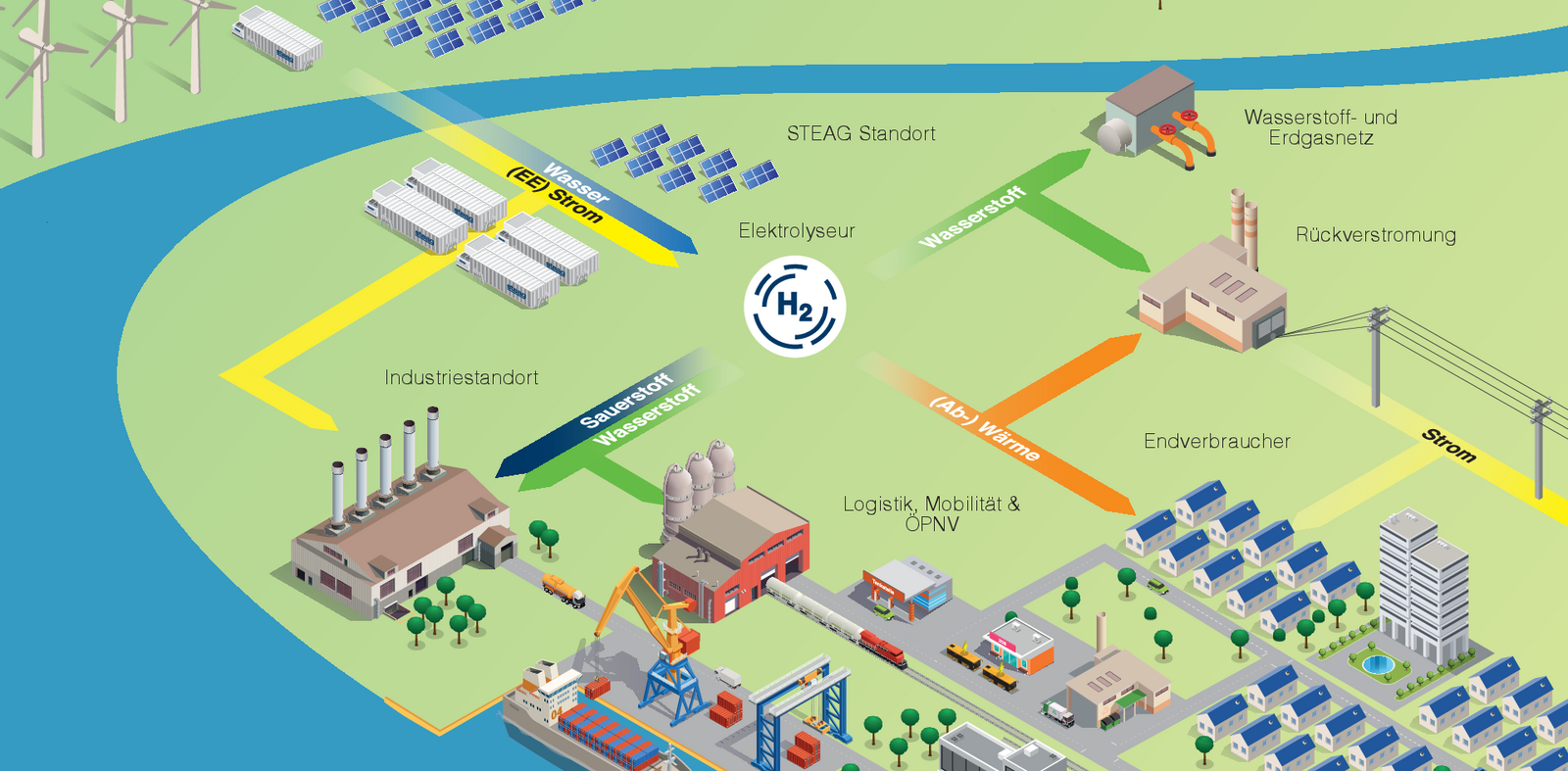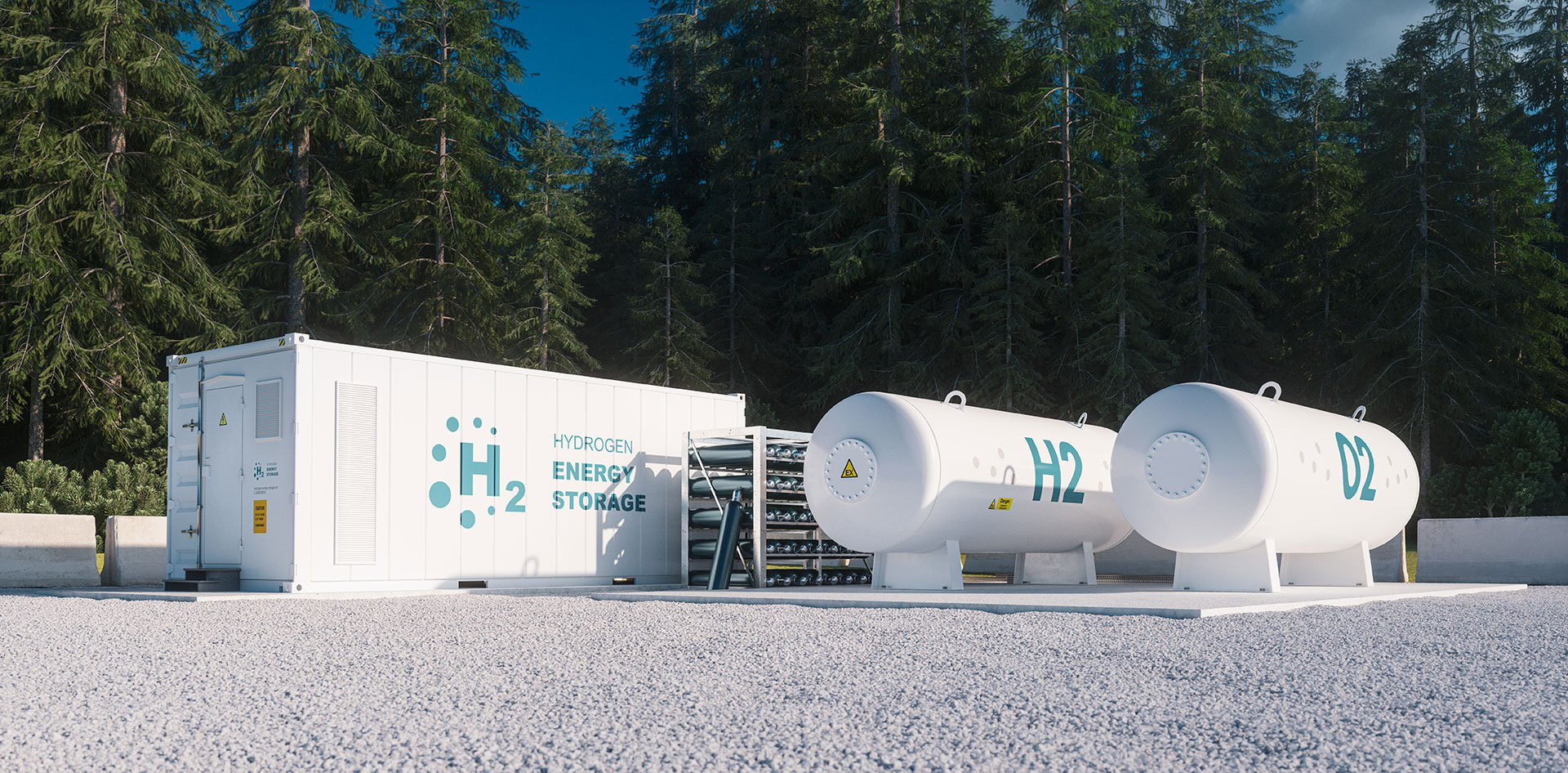Green hydrogen is produced by electrolysis, with the electricity used being generated from renewable sources such as wind and solar energy.
Hydrogen – green energy medium of the future
With the recently adopted hydrogen roadmap of the state of North Rhine-Westphalia and the strategies of the German government and the European Union, it has now at the latest become clear that hydrogen will be a key element for the successful implementation of the energy transition. Bringing together the production and demand for hydrogen will now be crucial for the development of a hydrogen economy.
Owing to the large number of industrial enterprises located in the vicinity of Iqony’s own sites and the good logistical conditions with water, rail and road connections, these sites offer enormous potential, for example for the construction of electrolyzers to be used in the production of green hydrogen. In addition to the necessary building land for the construction of such plants, they constitute strategically good locations for the development of a hydrogen infrastructure with their proximity to regionally based companies from industry and local public transport. Furthermore, the establishment of local green power and heat generation by implementing further components is also taken into consideration. In combination with photovoltaic systems and battery storage, the previous hard coal sites can be transformed into green energy hubs. The provision of local green electricity, green heat, green flexibility and the production of green hydrogen can add value across sectors in the implementation of the energy transition in the Ruhr region, and safeguard jobs.
In future, Iqony will integrate green energy in the form of electricity, hydrogen and heat into its own renewables portfolio and market them, and use the flexibility provided by the portfolio to supply its customers in line with demand.
Decarbonization of industry and establishment of a hydrogen infrastructure
Key facts on the topic of hydrogen
What is hydrogen, then?
Hydrogen is more than a universal energy source. It is a storage medium, it is regarded as an important link in successful integrated energy solutions due to its mutability and, in the form of the secondary products that can be produced from it – keyword “Power-to-X” – it is to become the decisive lever in decarbonizing, i.e. making CO2-free, particularly energy-intensive industries such as the iron and steel and cement industries, and the transport sector and especially aviation.
It is the declared aim of politicians to make Germany an international pioneer in the field of hydrogen. The economic stimulus package which the Federal Government adopted in summer 2020 to combat the economic consequences of the coronavirus crisis already provided for seven billion euros in subsidies. A further two billion euros are to go to international cooperation projects. A key aspect here is the development of a generation infrastructure to ensure that hydrogen will in future be produced primarily as “green” hydrogen, i.e. using electricity from renewable sources. Only then will the hydrogen that makes up the energy dreams of the future remain emission-free on the balance sheet, making it an effective instrument for achieving climate protection targets.
Color code for hydrogen
In the current debate, different color properties are often attributed to hydrogen; there are therefore mentions of “green”, “turquoise”, “blue” and “grey” hydrogen. The various colors stand for the relevant emissions connected with the relevant hydrogen. These emissions themselves depend on the manner in which the hydrogen was produced.
Green hydrogen
Green hydrogen
Turquoise hydrogen
Turquoise hydrogen
Turquoise hydrogen is produced from natural gas by methane splitting.
Blue hydrogen
Blue hydrogen
Blue hydrogen is produced from fossil fuels such as natural gas or coal, where the carbon dioxide released in the process is captured and stored.
Grey hydrogen
Grey hydrogen
Grey hydrogen is produced in the same way as blue hydrogen – with the decisive difference that the CO2 released in the process is not captured and stored, but rather emitted.
Working paper
Our podcast episodes on the topic of hydrogen
Episode 3: 36 minutes on the most common element in the universe: hydrogen
Daniel talks to Julius Okon, responsible for project planning around hydrogen at Iqony, about the most common element in the universe. (only german)
Special episode: Hydrogen project "HydrOxy
The HydrOxy joint project is concerned with the construction of a water electrolysis plant with a capacity of 500 MW on the Iqony site in Duisburg and is intended to serve the nearby thyssenkrupp Steel plant with green hydrogen and oxygen. (only german)


![[Translate to English:] C) euroluftbild.de/Hans Blossey](/fileadmin/user_upload/Presse/Pressefotos/STEAG_Presse_Wasserstoff.jpg)
![[Translate to English:] STEAG GmbH](/fileadmin/user_upload/AKTUELL_PLUS/2020/2_2020/STEAG_AKTUELL-PLUS-2-2020-Projektskizze.jpg)